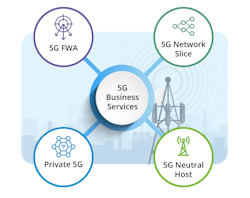The Gateway to 5G Business Services
From enhanced connectivity and security to network AI, 5G gateways have a multitude of benefits.
The importance of 5G technology grows significantly in the fast-paced world of digitalization, where a myriad of endpoint devices, from virtual reality headsets to robotic machinery, are becoming commonplace. It offers effective service differentiation and agile customization of network resources based on application requirements.
When considering 5G ecosystems, there’s an element that, while critical, is often overlooked. This is the 5G gateway, which plays a crucial role in enabling a wide array of business services.
…5G gateways can augment 5G visibility by adding endpoint device information. This enhancement not only includes basic identification of the endpoint devices but also extends to gather comprehensive data about the operating systems they run and their capabilities.
So, let’s look at the role of 5G gateways in enhancing networking and security functionalities, both for non-5G and 5G-enabled devices.
Typical 5G Use Cases and Business Services
5G gateways are integral to any public or private 5G business service (see Figure 1). For example:
- 5G FWA (fixed wireless access): Typically involves the connection of business locations to the internet and cloud services using public 5G networks. 5G FWA serves as an alternative to traditional wired broadband connections.
- 5G Public Slice Services: These are dedicated public 5G radio resources allocated to specific organizations or applications, often provided on-demand.
- Private 5G Services: Deployed within campuses such as industrial facilities or hospitals, as new local area networks (LANs). Private networks are often handled by managed service providers (MSPs) on behalf of the enterprise.
- 5G Neutral Host Services: These services involve the deployment and management of 5G radio networks by property owners or third-party entities, rather than by the mobile network operators (MNOs) themselves. This model is particularly useful in extending MNO coverage into areas where it might otherwise be difficult or economically unviable for individual MNOs to develop their infrastructure. Such services are advantageous not only for regular users but also for random users who happen to be in the vicinity, providing them with enhanced connectivity through these shared network facilities.
5G gateways vary depending on their intended use, spectrum availability (by a mobile operator, or by a business customer in the case of private 5G), and the need for industry-specific certifications.
Enhancing 5G Connectivity
The ongoing digital transformation necessitates the harmonization of IT and OT (operational technology) business processes, propelling a shift towards converged networks that cater to the requirements of both IT and OT domains. 5G gateways play a pivotal role in this harmonization by enabling seamless mobile, wireless, and wireline access to a unified 5G core infrastructure.
OT services require deterministic connectivity with the utmost reliability. 5G gateways contribute to reliability and maintain high standards of connectivity with intelligent traffic forwarding over multiple network links. Gateways can use a combination of links and network technologies (e.g., 4G, 5G, Wi-Fi, satellite) from one or more network operators. Enhanced network reliability considerations include:
- Overcoming network failures by switching traffic away from faulty links (and reverting to the primary link once it is restored).
- Minimizing packet loss by duplicating packets.
- Preventing bandwidth depletion by distributing the traffic load across multiple links.
In addition, the introduction of 5G in business OT networks sometimes requires Ethernet services to be “stretched” over 5G. This could be due to several reasons.
First, there are legacy industrial protocols in use in OT applications that rely on Ethernet, such as in Profinet, EtherCAT, and GOOSE. 5G is then used to backhaul Ethernet within a business campus or across sites. In such cases, industrial 5G gateways need to simultaneously support both IP and Ethernet to accommodate diverse applications. Native Ethernet forwarding in 5G networks requires the 5G network and gateways to support Ethernet packet data units (PDUs).
Second, mission-critical applications require deterministic handling and the “stretching” of time sensitive networking (TSN) over 5G.
Enhancing Manageability and Security
The integration of private 5G networks into business environments brings forth management challenges. 5G networks are engineered to manage their endpoints, but when endpoint devices are connected through 5G gateways the 5G network manages the gateway, losing sight of the endpoint devices.
To address this, 5G gateways can augment 5G visibility by adding endpoint device information. This enhancement not only includes basic identification of the endpoint devices but also extends to gather comprehensive data about the operating systems they run and their capabilities.
By analyzing the applications handled by these devices, 5G gateways can tailor network capabilities to suit the specific needs of each connected device, thereby improving overall efficiency and user experience.
It’s also vital to understand the security posture of these endpoints. Assessing how well these devices can withstand and respond to potential cyber threats is becoming increasingly important in the context of the evolving threat landscape in 5G networks.
To streamline 5G policies in business environments, it's beneficial to align them with asset management practices and implement these policies based on device type. This approach enables the gateway to offer differentiated handling, like choosing appropriate network slices and private/public cloud destination, according to autonomously detected devices and their category.
A significant aspect of management challenges is the harmonization of security policies across all endpoints. Each device represents a potential entry point for security breaches, and hence, it's vital to maintain consistent security protocols across all of them. These gateways play a crucial role in implementing and maintaining security measures, safeguarding data integrity, and protecting against cyber threats. They act as control points for the flow of data between devices and applications.
Network Programmability and AI
5G networks provide developers with exposure functions to integrate network capabilities directly into their applications. With 5G APIs developers can obtain insights into network performance and gain control of 5G network functions. In that aspect, 5G gateway APIs expand the scope of visibility and dynamic control to individual endpoint devices. For example, 5G gateways can provide location information and wireless reception quality in mobility use cases.
5G gateways are also increasingly being utilized to host AI workloads, commonly referred to as Edge AI, allowing for distributed and real-time insights. This integration of AI into the 5G far edge brings about a multitude of benefits, primarily in the form of AI-based insights and predictions. These insights can be crucial for making real-time automated decisions close to the endpoints, which significantly enhances the responsiveness and efficiency of network operations.
One use of this technology is in network health monitoring and management. AI algorithms can predict potential issues in network health, enabling proactive measures for maintaining network integrity. This predictive capability is vital for intelligent steering decisions, which involve dynamically adjusting network resources and routes to optimize performance and prevent downtime.
Additionally, AI can be utilized to make predictions related to application requirements, determining the necessary network resources to ensure smooth operation.
Developers can leverage these AI-generated insights and predictions through APIs, integrating them into their applications. This integration can significantly enhance the functionality of applications, making them more adaptive, efficient, and intelligent.
5G gateways represent a fundamental component in the evolution of 5G networks, acting as the linchpin between endpoint devices and applications. Beyond facilitating connectivity, these gateways enhance networking reliability, ensure security compliance, and streamline asset management ubiquitously across device types.
About the Author

Sharon Rozov
Chief Technology Officer, RAD
Sharon Rozov is Chief Technology Officer for RAD, a global leader in networking edge solutions. For more information, visit www.rad.com. Follow Sharon on LinkedIn. Follow RAD on LinkedIn and X.

